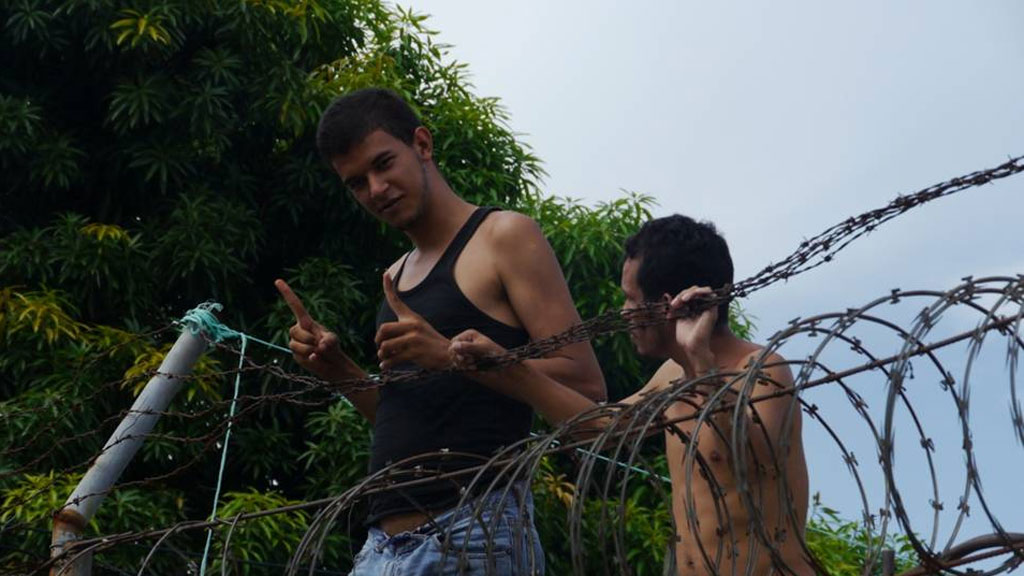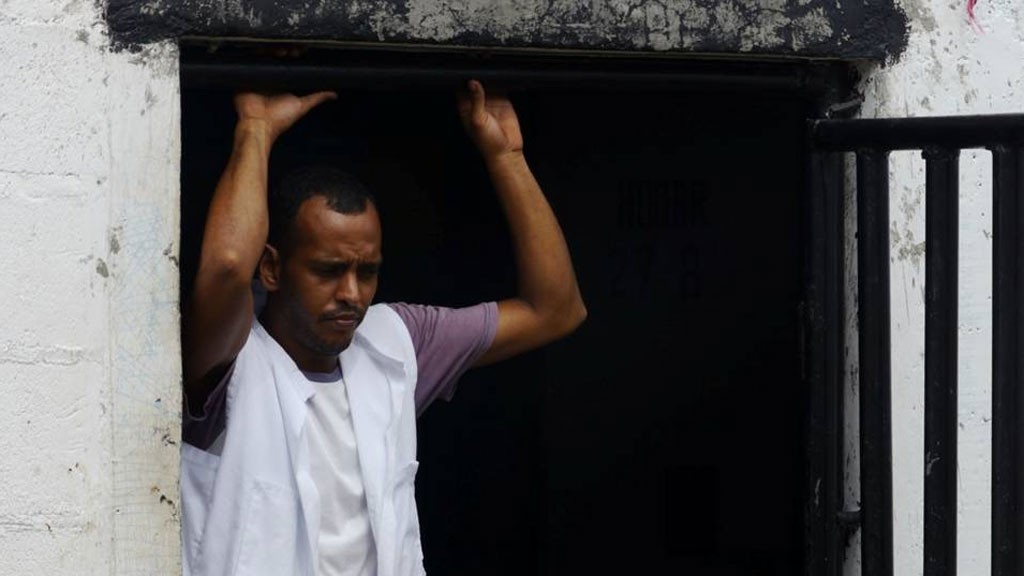A week in the murder capital of the world
 Guillermo Galdos
Latin America Correspondent
Guillermo Galdos
Latin America Correspondent
The city of San Pedro Sula in Honduras is reported to be the most dangerous place on earth outside conflict zones – with three murders every day. Filmmaker Guillermo Galdos reports for Channel 4 News.
Warning: This film contains graphic and distressing scenes from the start
In July 2013, I spent a week in San Pedro Sula, the murder capital of the world for two years running.
Travelling with producer Loretta Van der Horst, we found a city corrupted by fear and drug trafficking, where two gangs rule nearly every ghetto, known as a barrio.
More than 1,200 people were murdered last year alone. The government has put the army on the streets, but the violence continues as the gangs still rule.
Day one
There was a murder just a block from our hotel. The victim’s mother was covered in blood standing next to the body. Kids were standing around curiously looking at the scene, unaffected, as if it were normal.
The small crowd that gathered around the spectacle blocked the morning traffic and annoyed drivers honked as they passed by.
The city’s reputation for extreme violence didn’t take long to sink in. For weeks we had been talking to the two rival gangs ruling the neighbourhoods, the Mara Salvatrucha (MS) and the M18.
We were inside a place corrupted to its core.
Their order was clear. If we wanted to speak to them we had to go and ask their leaders in jail for permission.
On our first morning in San Pedro Sula we met Marco Antonio, one of the leaders of the MS, a street gang considered a criminal organisation by the US.
Marco was not in jail. He was allowed to visit an old people’s home to donate 50 beds made inside the prison as a way to tell society his gang wants to change.
We asked ourselves where they got the money to buy the beds, and extortion or drug trafficking seemed like plausible answers. Yet curiously, the Archbishop of San Pedro Sula, Romulo Emiliani, was there to bless such a generous offer.
That afternoon we went to a neighbourhood controlled by the MS to meet Marco’s fellow gang members. They were keen to show how they were protecting the people, that they were helping the schools.
They pointed out that in fact they had assumed the role of the state in their neighbourhoods. It was hard to understand how a bunch of criminals deported from the US at the beginning of the 90s had taken over the barrios and the cities of Honduras and now claimed to act as private security for the neighbourhoods.

Day two
On the second day we went on a tour with the army. They were keen to show us that they had gained control over some barrios.
The place looked like a ghost town. Entire blocks of houses were abandoned and many walls had been riddled by bullets. Many houses had graffiti on them, signs that marked off the territory of the gangs.
The army told us there had been fighting with the gangs just days before.
Entire blocks of houses were abandoned and many walls had been riddled by bullets.
That night we went on a patrol in a pretty tense neighbourhood. We drove in a five-truck convoy. A man was surprised outside his home and arrested. The colonel said it was because he was involved with the gangs.
The handcuffed man hunched into a ball inside the pickup and called home, saying he had been arrested and wasn’t going to be home for dinner. He pleaded with his wife: “Please don’t think that I am with another woman. I promise you I have been arrested.”
Day three
We started the day with a visit to the jail. We were going to meet the leaders of the Mara Salvatrucha gang.
Curiously it was the inmates we had to ask for permission to enter, not the guards. Their power as well as the smell of marijuana permeated the prison walls.
Inside they weren’t aggressive. It seemed like everyone was high. It felt more like a hotel in Jamaica than a prison.
The inmates called the shots here. They took us to the roof were they had installed a look-out to control what comes in and out of their fortress.
It felt uneasy knowing that most of the illegal money generated by the gangs comes back to the prison where the leaders have to pay millions in bribes to live the way they do. We were inside a place corrupted to its core.
That morning at least two people had been killed by the gangs. Outside the local morgue dozens waited for the bodies of their loved ones. We met Clara who was looking for her husband who disappeared two days ago.
She puts up a missing person’s poster on the morgue’s gate. A group of women next to her joke that he is so handsome he could have been stolen “by another woman”.
Clara doesn’t laugh. She is desperate. They have twins and a little girl together. After searching in hospitals, clinics, barrios, and practically every corner of San Pedro Sula, the morgue is the last place she visited.
She is afraid of talking about the gangs, and knows the consequences.

Day four
A local entrepreneur had agreed to speak to us about the extortion he had been suffering at the hands of the gangs. He was nervous and when he met us he didn’t look us in the eyes. Fear was all over his face.
He agreed to tell us his story if we made him unrecognisable. He pays the gangs more than $1,000 a month in “protection money”. But counting all of the transport businesses, they pay around $500,000 a month altogether; the so-called “war tax”.
If you don’t pay, your buses will be burnt. They might even kill you. It is the culture of fear. Nobody speaks about it, and nearly half of the gangs’ income is generated by extorting business that operate in the areas they control. The other half comes from drug trafficking.
Day five
On Friday night we went to the hospital. In less than two hours, four victims of violence arrived.
The place looked like a war hospital. A guy with two bullets in his head lay on a stretcher in the middle of the emergency room. His mother was desperately holding his hand, he was still breathing. It was a horrific scene.
They were kids high on drugs with guns, the worst combination.
She told us she knew the odds that her 22-year-old son would survive were non-existent. She thought this would never happen to her. Her kids were “clean”. But it did, and it was just another casualty of the gang war in Honduras.
Day six
We went to meet the M18 gang in a neighbourhood in the south of San Pedro Sula. After days of negotiating with the leaders inside the jail they agreed to let us film some of its members out on the streets.
It was tense. We had to do lots of talking before turning on the cameras. They were kids high on drugs with guns, the worst combination.
They spoke about murder as if it were normal. They admitted burying people alive. Shocking.
Day seven
On this day we went to the capital Tegucigalpa to interview President Lobo. He was all smiles, he seemed to be in a good mood.
He answered all of our questions and made a point of arguing that Honduras is cursed by geography. It lies between the South American countries that produce drugs and the biggest consumer in the north, making it an important transit country.
When we asked him about the jail where inmates seemed to rule, the president simply admitted there was corruption, as though it is normal for prisoners to control a jail.
Honduras has recently been listed as one of the most corrupt countries in the world.
-
Latest news
-
As India goes to the polls in the world’s largest election – what do British-Indians think?6m

-
Tees Valley: Meet the candidates in one of the biggest contests coming up in May’s local elections4m

-
Keir Starmer says public sector reform will be a struggle7m

-
Nicola Sturgeon’s husband Peter Murrell charged with embezzlement of funds from SNP1m

-
Ukraine might finally get $60billion in American weapons and assistance to defend against Russia3m

-




